Synology launched a trio of enterprise hard drives at 8TB, 12TB, and 16TB capacities along with a trio of “enterprise” NAS units. As part of the dual announcement, Synology is locking its new NAS units from using large hard drives from other vendors, instead only allowing its own hard drives to work in the units. Let us get into what is happening.
Video Version
Although we do not normally do videos for news, we have been getting a lot of questions about this, so we have a video:
As always, we suggest watching that in a YouTube tab. That video is meant to be listed in the background.
Synology HAT5300 Series
Synology is not manufacturing hard drives. Instead, the new Synology HAT5300 series is effectively made from re-branded Toshiba drives. There is an 8TB model at $239, a 12TB model at $349, and an upcoming 16TB model that does not have a price or release date yet. As part of the offering, Synology says it has done some firmware work on the drives to help increase performance. Indeed, Synology says the HAT5300 drives deliver up to “274MB/s sustained data transfer” and are up to 23% faster in sustained sequential read performance in demanding multi-user environments compared with other similar-class drives. Here is the performance testing footnote:
Performance testing was conducted by Synology using 12 drives on an SA3600, configured using RAID 5, against similar class drives (Enterprise) with IOMeter (64KB blocks). Results are for reference only. Actual performance may vary depending on workload, testing methods, and how devices and software are configured. (Source: Synology)
That performance note makes the 23% claim effectively useless since Synology is not naming the capacity nor drive they are using for comparison. A Western Digital HC550 18TB drive is both bigger and has a sequential transfer speed of 269MB/s and 252MiB/s. The Seagate EOS X18 drives can also hit 18TB and are rated at 270MB/s sequential transfer speeds. Again, since Synology’s performance note says IOMeter 64KB is being used along with MB/s, not MiB/s, the 23% faster rate assumes competitive drives operate only at 222MB/s. It seems Synology is using older generation drives as a comparison point.
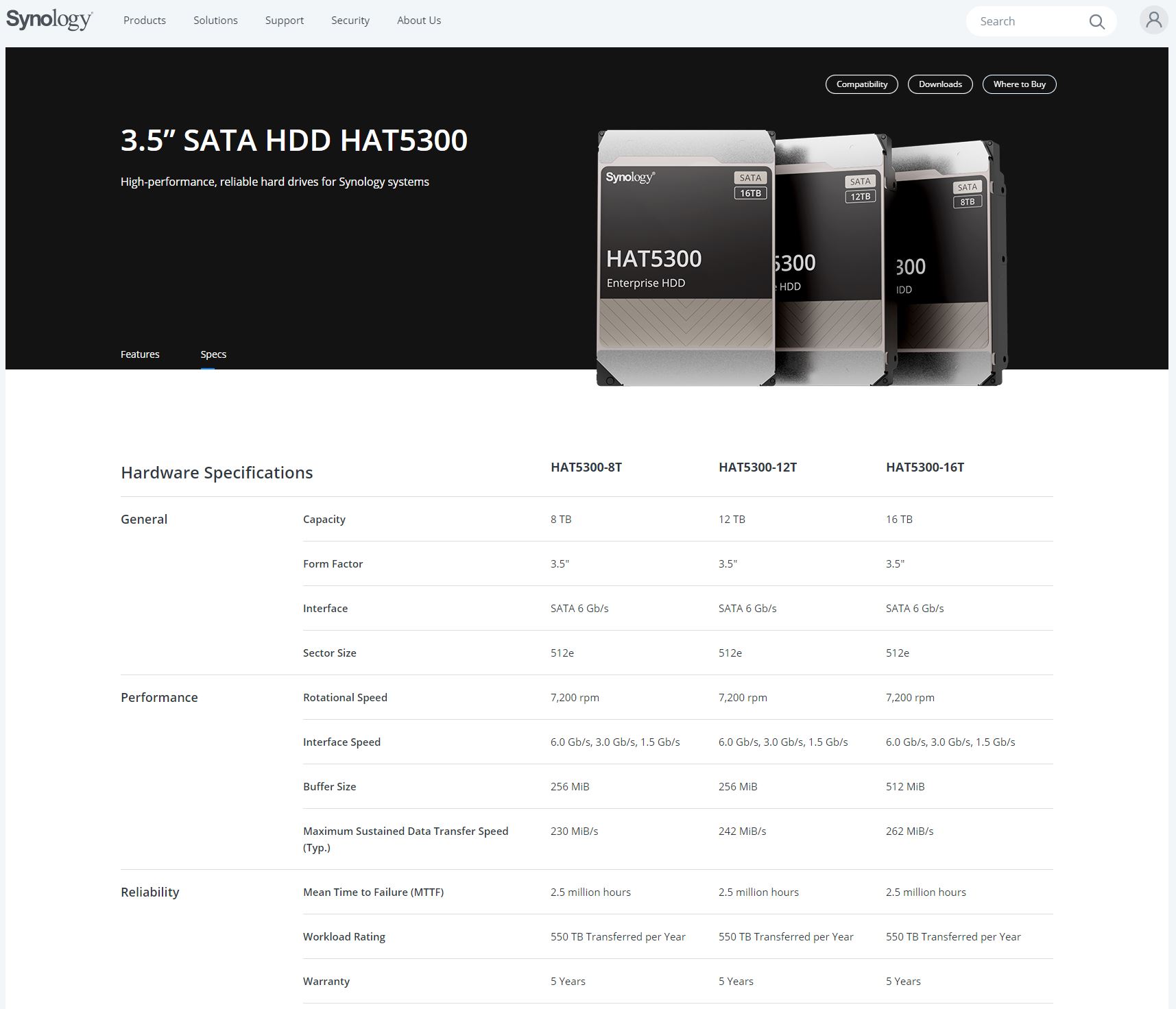
The move by Synology to release its own hard drives makes sense from a corporate perspective as it is a good way to show its investors continued revenue growth. The cost of the bare NAS itself is often half or less of the total system.
Synology Trio of New Enterprise NASes
Synology also has a trio of new NAS units that it is calling an Enterprise line. These NAS units do not necessarily have features such as Active-Active controllers (Synology has Active-Passive using external connections and software), dual-ported SAS drives, and other similar features. Instead, we think these units seem more of an attempt by the company to reach beyond the SMB space and into the SME space for the low-end of the enterprise market.
Synology RS3621RPxs
The first unit is the Synology RS3621RPxs. This is a 2U 12-bay unit:
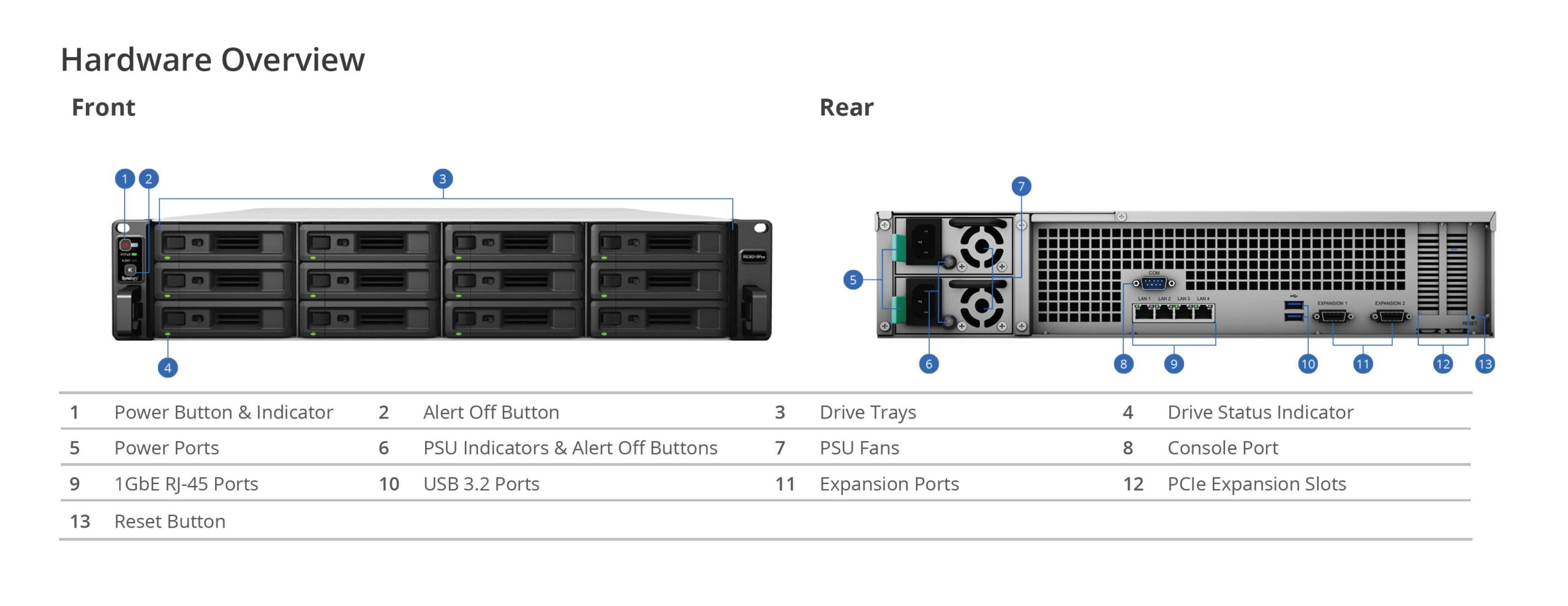
This unit has an Intel Xeon D-1531 (6C/12T) processor, 4x 1GbE networking, and an 8GB ECC UDIMM for memory.
Synology RS3621xs+
The second unit is the Synology RS3621xs+ which is a similar 2U 12-bay unit:
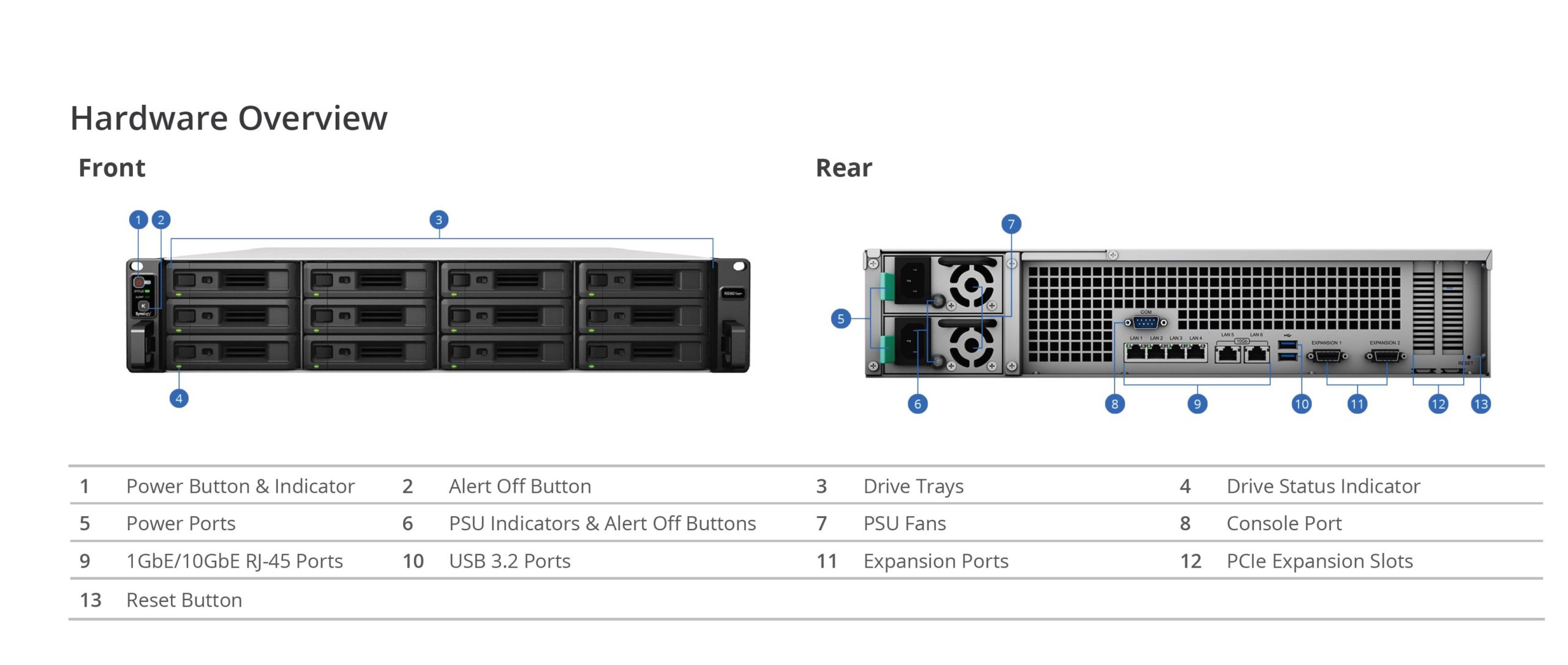
Here we get an upgrade to an Intel Xeon D-1541 8-core processor. This unit also adds dual 10Gbase-T networking as standard and keeps the 8GB ECC UDIMM. Memory capacity, like the other units in the trio, is listed as 64GB maximum.
Synology RS4021xs+
Finally, we have the Synology RS4021xs+ which is the 3U 16-bay option:
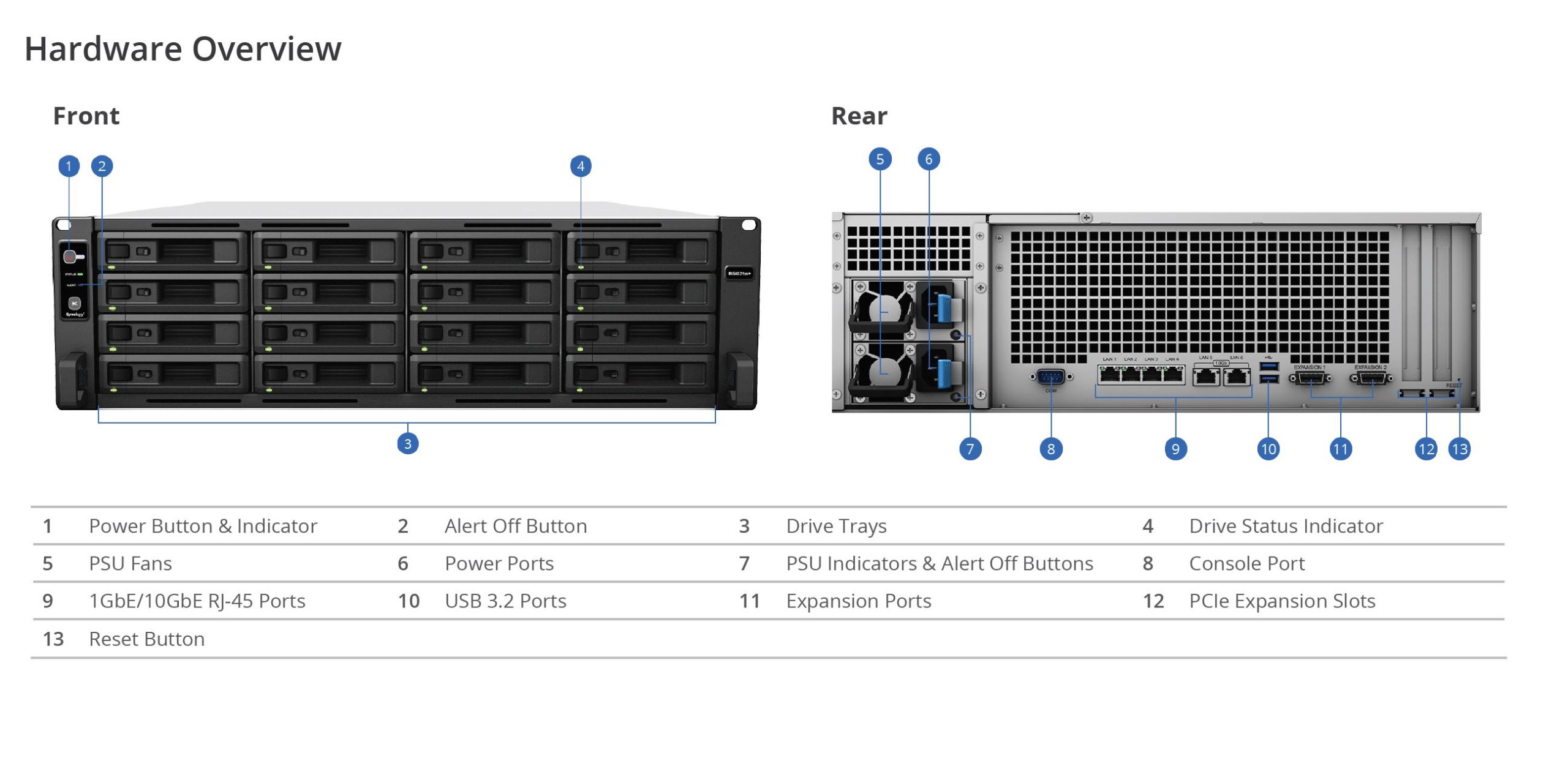
Here we get the same Xeon D-1541 and dual 10Gbase-T that we saw on the RS3621xs+. Aside from adding four more drive bays, this unit also upgrades to a 16GB ECC UDIMM.
Discussing the Specs: Infiniband
First off, we want to field a question we have received on these units multiple times: Infiniband. Listed on the spec pages for all of these units is 2x Expansion Ports (Infiniband).
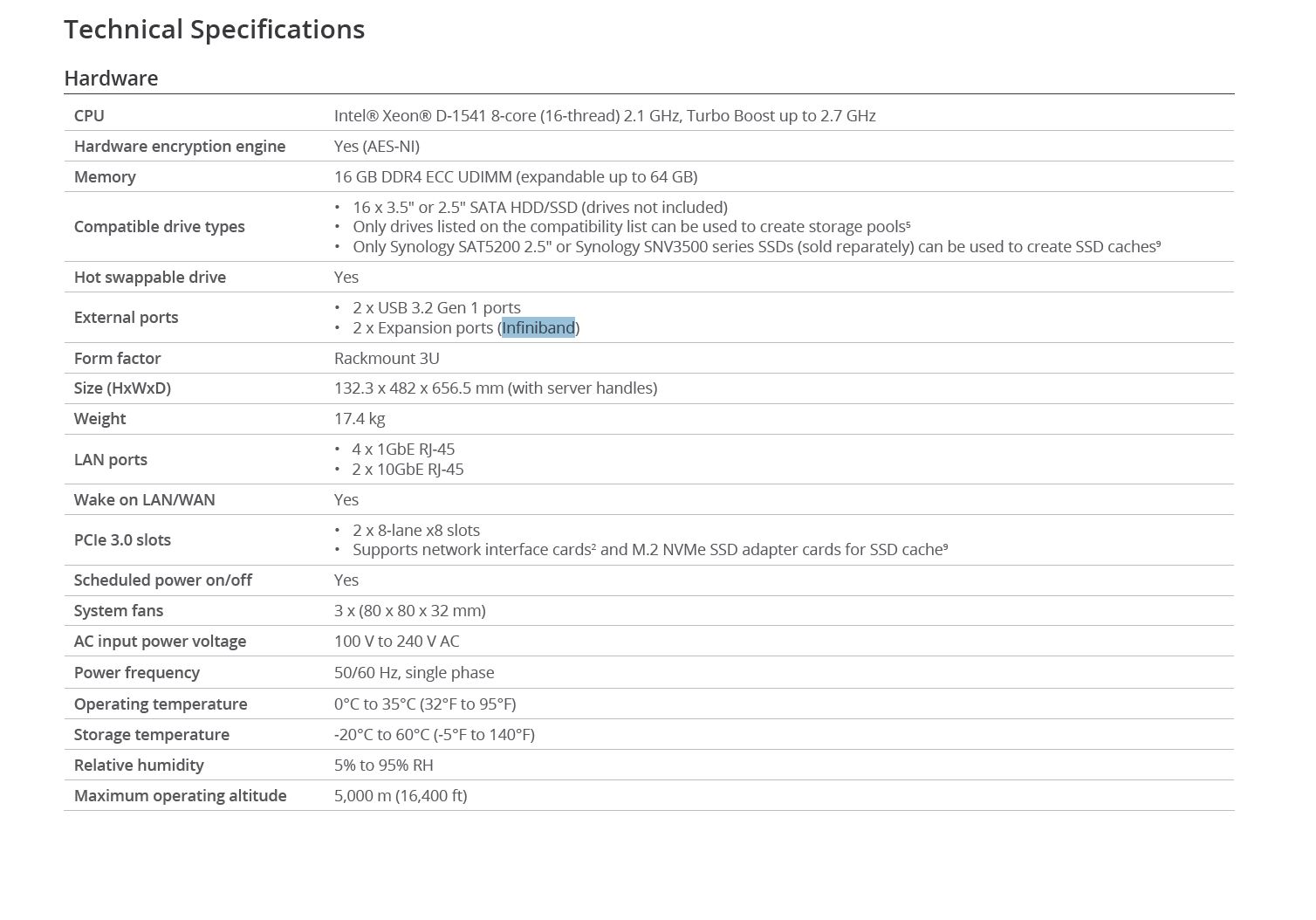
The Intel Xeon D series was launched in 2015. Intel Xeon D – Intel SoC Changing the low end with Broadwell-DE and Synology is using the post-Xeon D-1500 series and SR-IOV fixed variants of the chips with its new NAS units. Given the other I/O that the company is showing including dual PCIe 3.0 x8 slots, it is unlikely FDR/ EDR/ HDR Infiniband that could be repurposed into a high-end RDMA fabric.
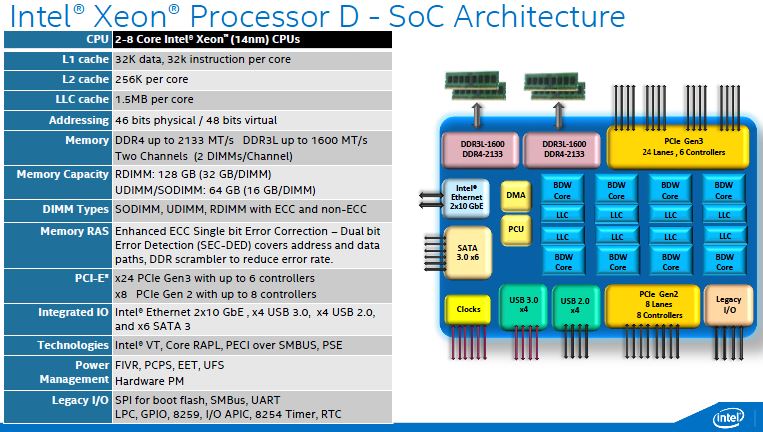
Instead, we think that what Synology is actually stating is that it uses a CX4/ SFF-8470 connector. This was a popular connector for Infiniband cables 10+ years ago. These are labeled as “11 Expansion Ports” on the units above. These ports are meant to connect to 1-2 disk shelves.
In the enterprise storage space, Infiniband has been used to connect multiple controllers together and also storage to servers. Indeed, Infiniband is often associated with high-performance storage today, but it started as a storage interconnect many years ago.
We hope that Synology clarifies this in its documentation.
Discussing the Specs: Xeon D and Networking
The Intel Xeon D-1500 series originally came out in 2015. After the SR-IOV issue effectively forced an updated chip from the launch Xeon D-1540 and D-1520, the company released new models, higher core count models (up to 16 cores publicly), and models with more networking. After the first generation Intel Xeon Scalable launch, we saw the Intel Xeon D-2100 series launch to bring the new architecture to the embedded market. We covered this evolution in exploring Intel Xeon D Evolution from Xeon D-1500 to Xeon D-2100. We also covered how the Twin Lakes Intel Xeon D-2100 platform powers Facebook. When the 2nd generation Intel Xeon Scalable series launched in 2019, Intel updated the D-1500 series with new higher clock speed parts in its Xeon D-1600 update.
Synology is using the Xeon D-1531 and D-1541 in its three new NAS units. These are Q4 2015-era parts. For new NAS units launched in 2021, that means Synology is still using current-generation parts, but they are certainly older.
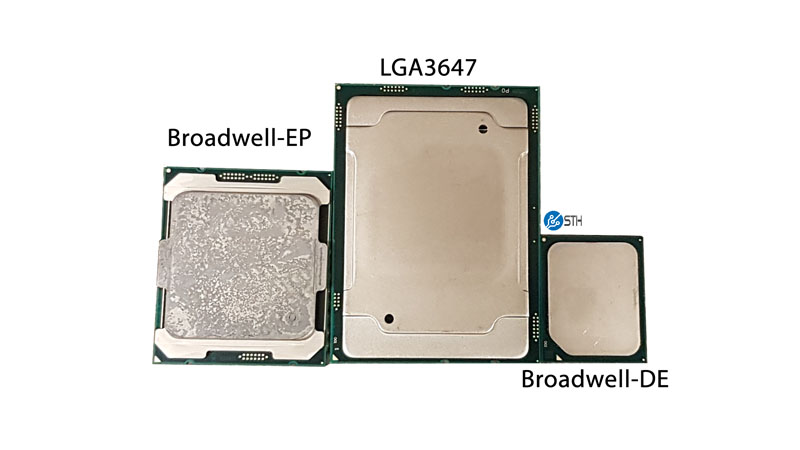
For some reason, Synology is selling these parts with ECC UDIMMs, not ECC RDIMMs and in single-channel memory configurations. The Intel Xeon D-1500 series is capable of up to 128GB of memory in dual channel memory configurations with 32GB ECC RDIMMs. 128GB may seem like too much for a storage server, but it seems like a missed opportunity to add higher-quality memory to its enterprise solution.
Networking on the three units is quad 1GbE or quad 1GbE plus dual 10Gbase-T. If one looks at the 2021 generation of servers, 25GbE will be commonplace. Even in 2020 STH was using 25GbE on many servers just because it is a nominal cost upgrade over 10GbE and 25GbE enterprise switch port is growing so quickly. A great example is that in our recent HPE ProLiant DL380T Gen10 Trusted Supply Chain Server Teardown we effectively had the lowest-end configuration that HPE could put together but that even had a dual 10/25GbE NIC.
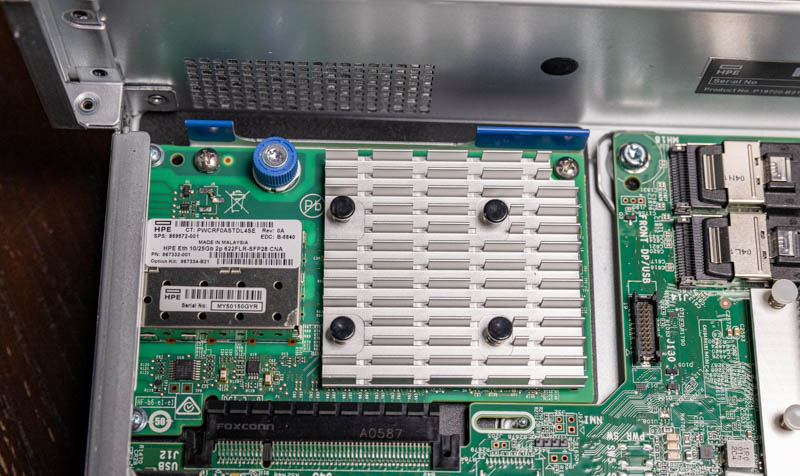
Between the processors, memory, and networking, the new Synology units seem like what would have been deemed “safe” or “mature” technology in 2017 or 2018. In 2021, this hardware feels almost a generation behind.
For Synology to break into the Enterprise market, we would have liked to see the company do something interesting from a hardware standpoint that was forward-looking into 2021 rather than safe in 2017-2018. Synology has large hardware margins given its pricing which makes sense given its software and warranty. At the same time, there was room to move to a platform that is more modern than state-of-the-art in 2015.
Discussing the Specs: Locking Hard Drives
Perhaps the biggest topic of discussion is locking the three new enterprise units to a compatibility list of hard drives. In the consumer/ SMB space, Synology would be directly going against customer expectations if they were to implement this. In the enterprise space, this makes a lot of sense.
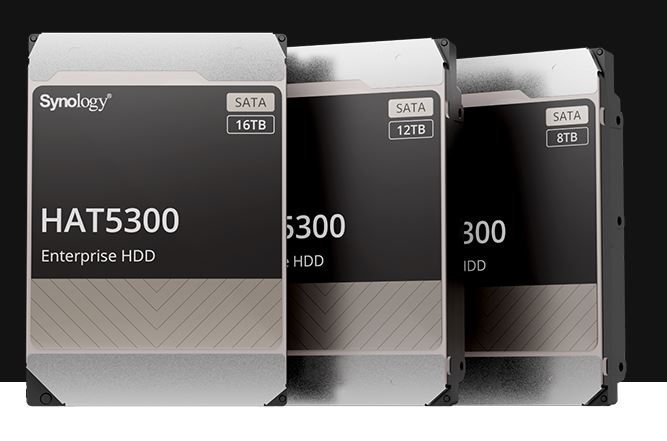
An enterprise storage product is designed to be a package. The software, system, and drives need to be qualified and supported by a vendor. If something goes wrong, enterprises expect to turn to the storage vendor and get an answer. If vendors supported any drive into systems, then it would be nearly impossible to test and it would create a situation where the system vendor could point to the drive vendor and the drive vendor could point to the system vendor.
In order to move into the market, Synology needed to do some type of enforcement. Having a software lock that prevents other types of storage from being used is perhaps extreme, but it is how Synology is dealing with this transition.
Many enterprise vendors effectively do this. There are Seagate and HGST drives out there with special model numbers for large storage vendor arrays. The difference is that Synology is replacing the hard drive vendor label with its own instead of just changing a model number. Synology does support non-Synology drives in low capacities, but not supporting more modern densities is a signal of where this is heading.
Perhaps the biggest challenge at this point is that Synology is using only Toshiba drives, and has very limited capacity points. That is far from a robust supply chain and limits Synology buyers to relatively small capacities. While Seagate/WD are offering 18TB/20TB models, Synology has announced a 16TB model but only has 12TB available now. That means that competitive enterprise platforms can be 50%+ denser than what Synology can ship today in its new Enterprise units.
Hopefully, this is something that expands to multiple vendors and multiple capacity points in the future.
Final Words
What started out as a “news” post ended up encompassing analysis and even a video from Patrick our Editor-in-Chief. We have received a lot of questions about these Synology announcements recently, so we wanted to get into it in more detail.
We hope going into this level of detail helps our readers understand what Synology is doing, and why. We also hope it clears up some of the questions around the hardware. STH did most of its Xeon D-1500 series coverage before I started writing, but that coverage is one of the reasons I gravitated towards the site.

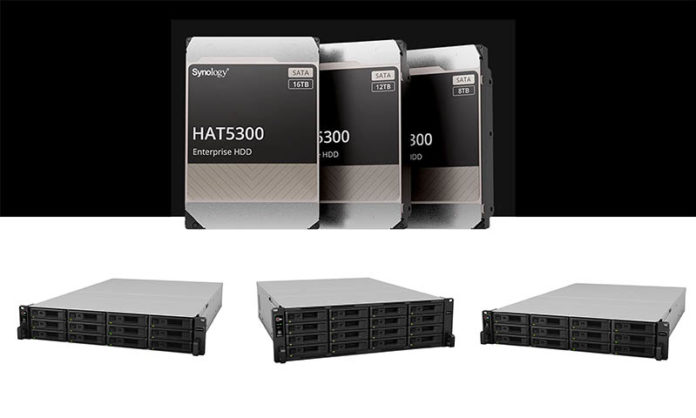



I am wondering if they will do something similar in the Consumer side of things. No one wants to install HDD and lots of setup just for it to work. They should have the option of selling as a single product like Apple Time Capsule.
so the basic strategy of mixing drives brands/batches to prevent multiple simultaneous failures doesn’t work anymore. That’s just a silly and purely stupid marketing driven decision.
STH “Yo we operate on a whole different level”
Great analysis
Having a software lock that prevents other types of storage from being used is perhaps extreme, but it is how Synology is dealing with this transition.
Citation needed. I have scoured the synology site and cannot find any official notice of this. Yes they show in their compatibility chart that they will only off support if using certified drives. But that is far different than locking out un certified drives.
@Ksec Sure they have the right – but it will backfire in the prosumer market, you can already see the user reaction on Reddit etc.. Personally, I looking at 2 new DS1621xs+, but this has made me bork.. whether they do or not, this was a PR disaster!
Synology are not Apple, a large chunk of the customer base are IT Pro at home, 1-Man Service Providers and Freelance Digital Material Producers… All of whom have a habbit of walking away from vendor tie-in.
Apple, don’t do it for the benefit of customers, it’s 99% to increase their margins and lock-out competition .. how they get away with it, I have no clue, they inhabit a whole different realm of existence.
Once upon, goes to show Marketing is driving this company, not sane engineers.
I shall no longer be suggesting Synology .
It is logical in RackStations to limit the HDD: but to include Enterprise drives like Seagate EXOS, a well respected drive.
Also, Synology HDD so far are SATA only, no SAS.
Having bought into Synology lately (wanted to have something simple), I find their software lacking – it’s probably ok for the common user, but in a data center where you need a few things it’ll probably be better to get storage pod …
Everything you said about what Synology is doing by locking down this series of NAS units makes sense for them. More money coming in for them and they now have the option to sell full pre-made systems and know everything will work.
For me however I would never recommend this for my work because getting the hard drives for one would be a problem, I live in Australia and during our COVID-19 lockdown parts became hard to get from brands like Intel and WD let alone a random drive that wouldn’t be sitting on the shelves at the stores I could shop at.
If Synology sold them with the option of there drives pre-installed or you could use your own I could see that being a better solution but given the market out there for storage I think in many ways Synology wont get customers for these NAS units that otherwise would have bought them.
EMC, HP, etc. can get away with things like drive locking. Synology, not likely. It’s going to blow up in their face, and I hope it does. I jumped ship from them on the prosumer side when they decided to keep using the same old Celeron and C3000 chips in their NASes while QNAP and others had moved on to Ryzen and Xeon. Makes a huge difference when you want to run VMs on your NAS and not just use it for file storage.
“Buy only our razor blades” is a total non-starter.
Well at least QNAP does not do this with their enterprise xeon boxes….
Looks like I will be buying that in the future.
Little Synology enviously looking at the big guys like HPE and EMC and wants to be a chic and cool and respected big boy, too. This sounds like the stuff teenie TV soaps like “Junior (got) High (on fumes)” are made of….
I am surprised that you let them get away with “In the enterprise space, this makes a lot of sense.”
This is pure non-sense, if we buy a Synology we expect to be able to put the drives we want.
If this is a critical need for enterprise space, they can rename their range with a “-ENTEPRISE ” suffix that would have the drive lock and they can even charge an extra 500$ for this.
Synology continues their trend of overpriced yester-year garbage. *sigh* oh well there are plenty of better options out there for pro-sumer/enthusiasts.
Talking of other options, the QNAP TS-h1277XU-RP-3700X-32G is ~2-300€ cheaper than the rs3621xs+, has better proc, 4 x the ram, twice as many 10g ports and a better file system. I have heard the software might not be as good (haven’t used a Qnap for a over 10 years) but it looks like they have the hardware fight won.
I worked at a RAID vendor years ago as a drive support engineer and what Synology is doing makes sense from the support viewpoint. Too many people think that because a hard drive has a SATA or SAS interface they are all equivalent. In fact they all differ in the details and you continually have to tweak and modify the code to support the differences. On top of that, some drive models are just junk that ultimately give your customer a bad experience that they usually will blame on the array vendor. Being able to just throw in any drive is a good marketing point but once your array has wide acceptance with lots of different drives being used by customers it’s nothing but a support headache. You find yourself spending too much of your support time fixing problems on a few troublesome drive models just so marketing can say it works with all drives.
Like the article I don’t understand the rebranding of Toshiba drives. Probably it comes down to only Toshiba with its small market share was willing to produce special drives for a small vendor like Synology. WD and Seagate just wouldn’t bother.
Can someone link to the actual release stating they are restricting/locking vendor support for drives on these new SANs?
@Clay
it’s right there in the technical specifications: “Only drives listed on the compatibility list can be used to create storage pools”. (These technical specifications are part of the datasheet for each of the units, which you can find on the product page for each unit at Synology’s website…)
Reads like antitrust, as if another company is seeking to compete with elected government.
Didn’t dell try this exact thing once, just to get so much blow back that they unlocked their servers to be able to use other drives?
Cracks me up that anyone takes Synology seriously
Evan Richardson
Was Dell locking AMD CPUs to a spec server – Dell’s storage side is called EMC
I’ve been a sysadmin for quite a few years, and other than a few SANs, I know of no one vendor who restricts drives. None of my Poweredges require me to use Dell drives, nor do any of my HPs require me to use vendor-locked HPE drives.
If Synology thinks they’re EMC, they’re in for an epic bitch-slap.
I see no evidence of Synology locking which drives go into the systems.
When I looked at for example the RS4021xs+ their standard text about storage says
“It is strongly recommended that you only install drives listed on your device’s compatibility list. Storage pool and volume creation processes may fail when using unverified drives. Synology is unable to provide technical support for devices using unsupported components.”
Naturally the compatibility list is limited (at least at the moment), but there are drives from Toshiba, Seagate and Western Digital there, so no lock-in to only Synology branded ones.
Billy – this was confirmed by Synology. They are only doing it on some models.
Having ordered a RS4021XS+ without knowing this vendor lockup, I was in serious trouble with my 16 EXOS 18 Tb drives when I discovered the warning message from the storage manager and there was no more any temperature display, bad sectors, S.M.A.R.T !
Fortunately I found quickly a hack of the DSM on the internet and edited the db file inside the DSM and now my drives work flawlessly.
I plan not to update anymore DSM 7.0 because it could wipe my hacked file.
In the future, I’ll give a try to QNAP which have much better hardware and no unfair policy.